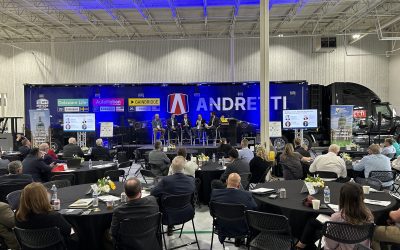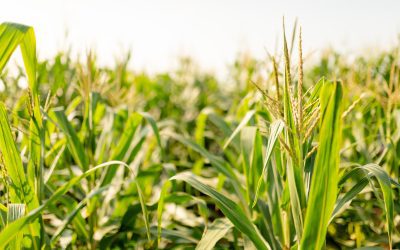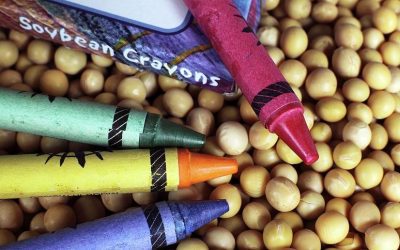According to his wife, Sheryl, Mark Seib is a “volunteer-aholic:” He has been or is involved with more than 20 organizations or committees for the betterment of agriculture, his state and his community.
Seib’s commitment to these causes is rooted in his upbringing on his family’s fourth-generation farm and the importance of giving back. Near Poseyville in southwestern Indiana, the farm began under Seib’s maternal great-grandmother, Sophia Mahrenholz, in 1898. It was her son – the first farmer in the community to have a farrowing house – who was most influential in Seib’s decision to continue the family tradition in agriculture.
“Grandpa had infinite patience with me as I worked beside him,” Seib explained. “One thing that stands out in my memories was his enormous hands. Those hands taught me many lessons I still use on the farm today.”
Seib’s hands have been full since age 9, when he began helping on the farm chopping cornfields with a two-row bush hog and an International Harvester tractor. Initially, the farm became a farrow-to-feeder and grain (corn, wheat and soybeans) operation. Through time, new hog buildings were added, and the production shifted to farrow-to-weaner.
They exited the hog operation when Seib’s brother returned to the farm following college and working offfarm. Today, his parents are retired, and his brother and two nephews have joined the grain enterprise.
Giving back is important to Seib, who proudly claims being the first farmer to be president of the Posey County Chamber of Commerce. “We have to give back. This is an industry where we don’t have a lot of people who are spokespeople or leaders. We have to promote our own industry,” he urged. “Before I got involved on what was first the Indiana Soybean Board, now the Indiana Soybean Alliance (ISA), it didn’t take me long to see Indiana farmers weren’t getting their just returns.
“We, as producers, can help the industry. We need to have our 30-second ‘elevator speech’ always at the ready on why we farm, and communicate with the public how important it is to their lives that food doesn’t come from just the grocery store.”
His goal when beginning to work with the checkoff was to have a good return on investment (ROI) for Indiana producers. “I am extremely proud that the ISA, American Soybean Association and the United Soybean Board (USB) are creating more markets,” said Seib, who is on USB’s executive committee and was appointed to it by former USDA Secretary Sonny Perdue.
“Who would have ever thought we could take a soybean and feed aquaculture? According to ISA, aquaculture is the fastest-growing use for soybean meal worldwide. Research has shown each species has to have a different percentage of soy in its diet. Fish aren’t as abundant as they once were, so we are subsidizing their diet.
In 2019, USB commissioned an ROI study to assess the value of checkoff investments made by farmers. “The ROI report shows for every $1 from the soybean checkoff, the return is $12.34 back to the farm. That’s a great return for soybean farmers.”
Seib further noted the market now includes Indiana launching a new concrete durability enhancer containing soy that adds years to bridges and asphalt. Nearly all household paint, some Goodyear tires, some crayons and most Ford car seats have soy in them, thanks in part to soybean checkoff investments into new use products at the state and national levels. The 27 year, ISA-sponsored Purdue Student Soybean Innovation Competition has also played a part in these successes.
Lower Mississippi River basin project
Perhaps one of Seib’s most notable “give-backs” is serving as USB’s leader in the core investing, planning and analysis of dredging the Lower Mississippi River basin.
“While earlier chairing USB’s sustainability committee, I learned how important a project the river dredging would be,” he said. “USB – America’s farmers – helped provide $1 million in checkoff funds to help fund research for the project. This is the first phase of lowering the river.”
As the largest-volume port in the United States, the basin and its other ports comprise a major gateway to the U.S. export economy. According to a 2019 river basin documentary featuring Seib, 60 percent of U.S. grain and other exports ship out there every year. No other country has the advantage of a major river system and a one-port complex. The dredging project focuses on the basin’s sediment at 45 feet. Dredging will deepen the basin’s limit to 50 feet, while using the sediment to enhance a two-mile wetland near the basin. Sean Duffy, executive director of Big River Coalition, explained, “Brazil, our No. 1 competitor, is already loading boats at 50 feet, and we’re losing business to them. The effort to lower the river from 45 to 50 feet will make us competitive in the world by loading larger-size ships that leading import countries are accepting. “Much of what happens in our economy
“The ROI report shows for every $1 from the soybean checkoff, the return is $12.34 back to the farm. That’s a great return for soybean farmers.”
happens on that river. We want to be No. 1, but we are No. 2 or No. 3 in the world. The U.S. has the most miles of navigable waterways, we have the largest ag area in the world – and if we don’t maximize those benefits, we lose face. As a world leader, we’re talking about American jobs and stimulating the economy.”
Paul Aucoin, executive director of the Port of South Louisiana, noted the Mississippi River Basin, as the largest foreign trade zone in United States, produces $51 billion in trade cargo annually. In 2018, the U.S. Corps of Army Engineers report concluded the deepening would add $127.5 million per year to the nation’s economy; the river basin accounts for $750 billion a year in the economy and more than 2.4 million jobs.
Duffy noted for every dollar invested, there will be a $7.20 return on investment: “This project will pay for itself in two years.”
Seib emphasized agriculture would be one of the project’s biggest beneficiaries. “For the American farmer, being able to have this dredging project completed should bring basis to their soybean price, and it should bring a better price than we’re getting with more going out the door through exports,” he said. “It will also allow for more of our soybeans to be utilized.
“Each American soybean farmer could add 5 or 10 cents to their basis. So, it’s a huge plus all the way down the channel. This is a big win for farmers because they’re contributing to it.”



